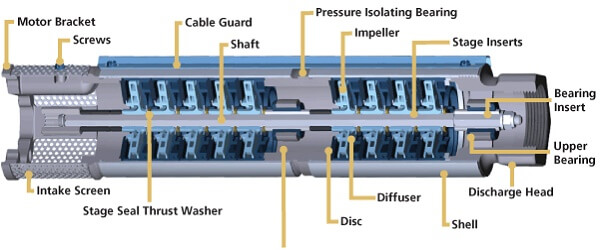Submersible Waste Water Sewage Pumps
The photos above show the typical "single-stage" submersible pump that is used extensively in industry today. Typical applications for the single-stage pump include drainage, sewage pumping, general industrial pumping, pond filters and slurry pumping. The submersible pump dates back to 1928 when a design was used in an oil field application. Then in 1929, Pleuger Pumps pioneered a multi-stage design that was the predecessor to today's multi-stage turbine pump.
One of the multi-stage designs that will come to mind quickly is the "residential submersible well pump". This is a "bore-hole" design that is long and slim in appearance.
This is a "true" multi-stage design that is used heavily in the residential fresh water well pumping applications. As you can see from the photo above, the nature of the numerous stages through which the water is transported from the intake on the left (bottom of the well) to the discharge head on the right (toward the top of the well). Multi-stage "fresh water pumps" of this nature, also referred to as "turbine pumps", will be covered in another topic that you can link to by clicking here. Because of that, we'll continue on in this topic, with our discussion of "Submersible" single-stage pumps.
What is a Submersible Pump
Using a definition from Wikipedia.org, the "Submersible Pump" is defined as follows:
"A submersible pump is a device which has a hermetically sealed motor close-coupled to the pump body. The whole assembly is submerged in the fluid to be pumped. The main advantage of this type of pump is that it prevents pump cavitation, a problem associated with a high elevation difference between pump and the fluid surface. Submersible pumps push fluid to the surface as opposed to jet pumps which create a vacuum & rely upon atmospheric pressure. Submersibles are more efficient than jet pumps."
Electric submersible pumps are centrifugal pumps operating in a vertical position. Liquids, accelerated by the impeller, lose their kinetic energy in the diffuser where a conversion from kinetic energy to pressure energy takes place. Fluids enter the pump through an intake screen at the bottom of the pump and are lifted by the pump impeller. Bearings (bushings) along the length of the shaft provide radial support to the pump shaft.
Another design of submersible pump uses a screw-type impeller, as compared to the rather "open" design impeller on the standard submersible pump. This steel screw allows the pump to work in fluids with a high sand content and other mechanical impurities, with minimal mechanical wear.
Cooling Standards
A factor in the design of this type pump is the required cooling of the electric motor which is enclosed in a sealed chamber. The fluid that is being pumped passes around this chamber and therefore provides the cooling of the cast (and sealed) motor chamber through convection and conduction. Air is a poor conductor of heat. So the air around the motor is rather inefficient at removing the generated heat. Some manufacturers fill this chamber with an insulating oil that provides a better medium for heat conduction than that of the air alone. In ALL designs, however, there will normally be a "moisture" sensor within the motor chamber. If moisture (water, etc.) from the fluid being pumped works it's way into the motor chamber, it is detected by the sensor and a signal (by way of an electrical contact closure) is sent to the controls. This signal can either be in the form of a simple "warning light" or a "shut-down" of the pump to protect the motor from disaster.
Sealing
So the sealing of a submersible pump is critical to extending it's operating life (between repairs). Earlier designs relied entirely on "rubber" gaskets to keep out the contaminants and moisture. Today's users however, have the advantage of technological advances of various silicones and other man-made sealing methods. But these, too, must be chosen wisely. The curing agents in some sealants are harmful to the electrical windings of an electric motor and/or the insulation around the power and control cables. Sealing is critical, but it must be the correct material.
Cabling
Cabling is also a major consideration when it comes to submersibles. Submersible pump cables are designed for use in wet ground or under water, with specialized types based on the pump's environmental conditions. A submersible pump cable is a specialized product to be "specifically" used for a submersible pump in a deep well, a corrosive pit, or in similarly harsh conditions. The cable needed for this type of application must be durable and reliable, as the installation location and environment can be extremely restrictive as well as hostile. As such, submersible pump cable may be used in both fresh and salt water. It is also suitable for direct burial and within well castings. A submersible pump cable's area of installation is physically restrictive. The connection cavity (the allowable area for making connections), can be extremely small and cramped. Cable insulation and conductors MUST BE flexible and yet very durable. Cable manufacturers must keep these factors in mind to achieve the highest possible degree of reliability. The size and shape of submersible pump cable can vary depending on the usage and preference of the installer. Pump cables are made in single and multiple conductor types and may be flat or round in cross section; some types include control wires as well as power conductors for the pump motor. Conductors are often color-coded for identification and an overall cable jacket may also be color-coded.
Conclusion
Submersible pumps are a major factor in Waste Water Treatment Plants, Quarries (for dewatering), Emergency Services during natural disasters, and numerous other applications. So if you need to consider Submersibles in your next project, give us a call with your technical and/or application questions. We're here to help.

























 Back to Top
Back to Top